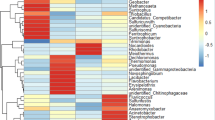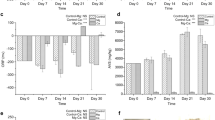Abstract
The control of black and odorous substances in sediments is of crucial importance to improve the urban ecological landscape and to restore water environments accordingly. In this study, chemical oxidation by the oxidants NaClO, H2O2, and KMnO4 was proposed to achieve rapid control of black and odorous substances in heavily-polluted sediments. Results indicate that NaClO and KMnO4 are effective at removing Fe(II) and acid volatile sulfides. The removal efficiencies of Fe(II) and AVS were determined to be 45.2%, 94.1%, and 93.7%, 89.5% after 24-h exposure to NaClO and KMnO4 at 0.2 mmol/g, respectively. Additionally, rapid oxidation might accelerate the release of pollutants from sediment. The release of organic matters and phosphorus with the maximum ratios of 22.1% and 51.2% was observed upon NaClO oxidation at 0.4 mmol/g. Moreover, the introduction of oxidants contributed to changes in the microbial community composition in sediment. After oxidation by NaClO and KMnO4 at 0.4 mmol/g, the Shannon index decreased from 6.72 to 5.19 and 4.95, whereas the OTU numbers decreased from 2904 to 1677 and 1553, respectively. Comparatively, H2O2 showed a lower effect on the removal of black and odorous substances, pollutant release, and changes in sediment microorganisms. This study illustrates the effects of oxidant addition on the characteristics of heavily polluted sediments and shows that chemical oxidants may be an option to achieve rapid control of black and odorous substances prior to remediation of water environments.

Similar content being viewed by others
References
Ajima M N O, Nnodi P C, Ogo O A, Adaka G S, Osuigwe D I, Njoku D C (2015). Bioaccumulation of heavy metals in Mbaa River and the impact on aquatic ecosystem. Environmental Monitoring and Assessment, 187(12): 768–776
Bailey S E, Olin T J, Bricka R M, Adrian D D (1999). A review of potentially low-cost sorbents for heavy metals. Water Research, 33(11): 2469–2479
Boers P C M (1991). The influence of pH on phosphate release from lake-sediments. Water Research, 25(3): 309–311
Chen M, Ding S, Gao S, Fu Z, Tang W, Wu Y, Gong M, Wang D, Wang Y (2019). Efficacy of dredging engineering as a means to remove heavy metals from lake sediments. Science of the Total Environment, 665(15): 181–190
Clement J C, Shrestha J, Ehrenfeld J G, Jaffe P R (2005). Ammonium oxidation coupled to dissimilatory reduction of iron under anaerobic conditions in wetland soils. Soil Biology & Biochemistry, 37(12): 2323–2328
Cloke P L (1963). The geologic role of polysulfides—Part II: The solubility of acanthite and covellite in sodium polysulfide solutions. Geochimica et Cosmochimica Acta, 27(12): 1299–1319
Daneshgar S, Vanrolleghem P A, Vaneeckhaute C, Buttafava A, Capodaglio A G (2019). Optimization of P compounds recovery from aerobic sludge by chemical modeling and response surface methodology combination. Science of the Total Environment, 668: 668–677
Davison W (1993). Iron and manganese in lakes. Earth-Science Reviews, 34(2): 119–163
Djouiai B, Thwaite J E, Laws T R, Commichau F M, Setlow B, Setlow P, Moeller R (2018). Role of DNA repair and protective components in bacillus subtilis spore resistance to inactivation by 400-nm-wavelength blue light. Applied and Environmental Microbiology, 84(19): e01604–e01618
Feng Z, Fan C, Huang W, Ding S (2014). Microorganisms and typical organic matter responsible for lacustrine “black bloom”. Science of the Total Environment, 470–471: 1–8
Fonti V, Beolchini F, Rocchetti L, Dell’Anno A (2015). Bioremediation of contaminated marine sediments can enhance metal mobility due to changes of bacterial diversity. Water Research, 68: 637–650
Galloway J N, Townsend A R, Erisman J W, Bekunda M, Cai Z, Freney J R, Martinelli L A, Seitzinger S P, Sutton M A (2008). Transformation of the nitrogen cycle: recent trends, questions, and potential solutions. Science, 320(5878): 889–892
Ghattas A K, Fischer F, Wick A, Ternes T A (2017). Anaerobic biodegradation of (emerging) organic contaminants in the aquatic environment. Water Research, 116: 268–295
He W, Shang J G, Lu X, Fan C X (2013). Effects of sludge dredging on the prevention and control of algae-caused black bloom in Taihu Lake, China. Journal of Environmental Sciences-China, 25(3): 430–440
Horppila J, Holmroos H, Niemisto J, Massa I, Nygren N, Schonach P, Tapio P, Tammeorg O (2017). Variations of internal phosphorus loading and water quality in a hypertrophic lake during 40 years of different management efforts. Ecological Engineering, 103: 264–274
Hsieh Y P, Chung S W, Tsau Y J, Sue C T (2002). Analysis of sulfides in the presence of ferric minerals by diffusion methods. Chemical Geology, 182(2–4): 195–201
Hu J, Qiao Y, Zhou L, Li S (2011). Spatiotemporal distributions of nutrients in the downstream from Gezhouba Dam in Yangtze River, China. Environmental Science and Pollution Research International, 19(7): 2849–2859
Lanciotti E, Santini C, Lupi E, Burrini D (2003). Actinomycetes, cyanobacteria and algae causing tastes and odours in water of the River Arno used for the water Supply of Florence. Journal of Water Supply: Research & Technology- Aqua, 52(7): 489–500
Liu X, Tao Y, Zhou K, Zhang Q, Chen G, Zhang X (2017). Effect of water quality improvement on the remediation of river sediment due to the addition of calcium nitrate. Science of the Total Environment, 575: 887–894
Ma M, Liu R, Liu H, Qu J (2012). Effect of moderate pre-oxidation on the removal of Microcystis aeruginosa by KMnO4-Fe(II) process: significance of the in-situ formed Fe(III). Water Research, 46(1): 73–81
Muyzer G, Stams A J M (2008). The ecology and biotechnology of sulphate-reducing bacteria. Nature Reviews. Microbiology, 6(6): 441–454
Naceradska J, Pivokonsky M, Pivokonska L, Baresova M, Henderson R K, Zamyadi A, Janda V (2017). The impact of pre-oxidation with potassium permanganate on cyanobacterial organic matter removal by coagulation. Water Research, 114: 42–49
Nielsen L P, Risgaard-Petersen N, Fossing H, Christensen P B, Sayama M (2010). Electric currents couple spatially separated biogeochemical processes in marine sediment. Nature, 463(7284): 1071–1074
Ololade I A, Zhou Q, Pan G (2016). Influence of oxic/anoxic condition on sorption behavior of PFOS in sediment. Chemosphere, 150: 798–803
Rajeshkumar S, Li X (2018). Bioaccumulation of heavy metals in fish species from the Meiliang Bay, Taihu Lake, China. Toxicology Reports, 5: 288–295
Rothe M, Frederichs T, Eder M, Kleeberg A, Hupfer M (2014). Evidence for vivianite formation and its contribution to long-term phosphorus retention in a recent lake sediment: A novel analytical approach. Biogeosciences, 11(18): 5169–5180
Rusch A, Topken H, Bottcher M E, Hopner T (1998). Recovery from black spots: results of a loading experiment in the Wadden Sea. Journal of Sea Research, 40(3–4): 205–219
Rydin E, Welch E B (1998). Aluminum dose required to inactivate phosphate in lake sediments. Water Research, 32(10): 2969–2976
Shen Q, Liu C, Zhou Q, Shang J, Zhang L, Fan C (2013). Effects of physical and chemical characteristics of surface sediments in the formation of shallow lake algae-induced black bloom. Journal of Environmental Sciences-China, 25(12): 2353–2360
Shen Q, Zhou Q, Shang J, Shao S, Zhang L, Fan C (2014). Beyond hypoxia: Occurrence and characteristics of black blooms due to the decomposition of the submerged plant Potamogeton crispus in a shallow lake. Journal of Environmental Sciences-China, 26(2): 281–288
Stahl J B (1979). Black water and two peculiar types of stratification in an organically loaded strip-mine lake. Water Research, 13(5): 467–471
Stauffer C E (1975). A linear standard curve for the Folin Lowry determination of protein. Analytical Biochemistry, 69(2): 646–648
Suanon F, Sun Q, Dimon B, Mama D, Yu C P (2016). Heavy metal removal from sludge with organic chelators: Comparative study of N, N-bis(carboxymethyl) glutamic acid and citric acid. Journal of Environmental Management, 166: 341–347
Tang Y Q, Li M, Zou Y A, Lv M Y, Sun J M (2018). Mechanism of aerobic denitrifiers and calcium nitrate on urban river sediment remediation. International Biodeterioration & Biodegradation, 126: 119–130
Tessier A, Campbell P G C, Bisson M (1979). Sequential extraction procedure for the speciation of particular trace metals. Analytical Chemistry, 51(7): 844–851
Vale S S, Fuller I C, Procter J N, Basher L R, Smith I E (2016). Characterization and quantification of suspended sediment sources to the Manawatu River, New Zealand. Science of the Total Environment, 543: 171–186
Worsfold P, McKelvie I, Monbet P (2016). Determination of phosphorus in natural waters: A historical review. Analytica Chimica Acta, 918: 8–20
Xu M Y, Zhang Q, Xia C Y, Zhong Y M, Sun G P, Guo J, Yuan T, Zhou J Z, He Z L (2014). Elevated nitrate enriches microbial functional genes for potential bioremediation of complexly contaminated sediments. The ISME Journal, 8(9): 1932–1944
Yang W H, Weber K A, Silver W L (2012). Nitrogen loss from soil through anaerobic ammonium oxidation coupled to iron reduction. Nature Geoscience, 5(8): 538–541
Yu J, Chen Q, Zhang J, Zhong J, Fan C, Hu L, Shi W, Yu W, Zhang Y (2019). In situ simulation of thin-layer dredging effects on sediment metal release across the sediment-water interface. Science of the Total Environment, 658: 501–509
Zaitlin B, Watson S B (2006). Actinomycetes in relation to taste and odour in drinking water: myths, tenets and truths. Water Research, 40(9): 1741–1753
Zhang R, Wang L, Wu F, Song B (2013). Phosphorus speciation in the sediment profile of Lake Erhai, southwestern China: Fractionation and 31P NMR. Journal of Environmental Sciences-China, 25(6): 1124–1130
Zhang X J, Chen C, Ding J Q, Hou A, Li Y, Niu Z B, Su X Y, Xu Y J, Laws E A (2010). The 2007 water crisis in Wuxi, China: Analysis of the origin. Journal of Hazardous Materials, 182(1–3): 130–135
Zhu Y, Fan W, Zhou T, Li X (2019). Removal of chelated heavy metals from aqueous solution: A review of current methods and mechanisms. Science of the Total Environment, 678: 253–266
Zuo Y, Li L, Zhang T, Zheng L, Dai G, Liu L, Song L (2010). Contribution of Streptomyces in sediment to earthy odor in the overlying water in Xionghe Reservoir, China. Water Research, 44(20): 6085–6094
Acknowledgements
This work was supported by the National Natural Science Foundation of China (Grant Nos. 51820105011, 51578537 and 51778603) and the Chinese Academy of Sciences (No. QYZDY-SSW-DQC004). The authors thank Beijing Genomics Institute Central China for providing high-throughput sequencing services.
Author information
Authors and Affiliations
Corresponding author
Additional information
Highlights
• Oxidants were proposed to rapidly control black and odorous substances in sediments.
• NaClO and KMnO4 had excellent efficiency to remove black and odorous substances.
• NaClO dramatically accelerated the release of organics, NH4+-N, P, and heavy-metals.
• Moderate oxidation had a limited effect on microbial communities.
• NaClO of 0.2 mmol/g was viewed to be the optimum option.
Supporting information
Rights and permissions
About this article
Cite this article
Li, K., Yang, M., Peng, J. et al. Rapid control of black and odorous substances from heavily-polluted sediment by oxidation: Efficiency and effects. Front. Environ. Sci. Eng. 13, 87 (2019). https://doi.org/10.1007/s11783-019-1171-y
Received:
Revised:
Accepted:
Published:
DOI: https://doi.org/10.1007/s11783-019-1171-y




